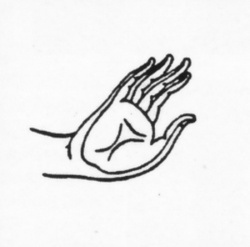Difference between revisions of "Abhaya Mudrā"
Jump to navigation
Jump to search
(Created page with "thumb|250px| <poem> Abhaya Mudrā or Abhayaṃdada Mudrā shīwúwèi yìn 施无畏印 施無畏印 This gesture vanquishes both fear and ...") |
|||
| Line 8: | Line 8: | ||
[http://anthro.ucsd.edu/~dkjordan/chin/shoouyinn/MudrasDescribed.html anthro.ucsd.edu] | [http://anthro.ucsd.edu/~dkjordan/chin/shoouyinn/MudrasDescribed.html anthro.ucsd.edu] | ||
[[Category:Buddhist Terms]] | [[Category:Buddhist Terms]] | ||
| − | [[Category:Mudra | + | [[Category:Abhaya Mudra]] |
Revision as of 11:56, 18 June 2013
Abhaya Mudrā or Abhayaṃdada Mudrā
shīwúwèi yìn 施无畏印 施無畏印
This gesture vanquishes both fear and hostility. It is said that once a vicious demon named Devadatta sent a drunken elephant to trample the Buddha. The Buddha raised his hand gently, and immediately the elephant was subdued. (This is probably a mythologized variant of the story told in chapter 25 of the on-line biography of the Buddha. The mudrā has therefore come to represent protection and peace and the dissipation of all fear in the believer. (Some say it is a pre-Buddhist sign used in greeting another person and signaling one’s good intentions.) This mudrā is often combined with the Wish-Granting Gesture (varada mudrā)
